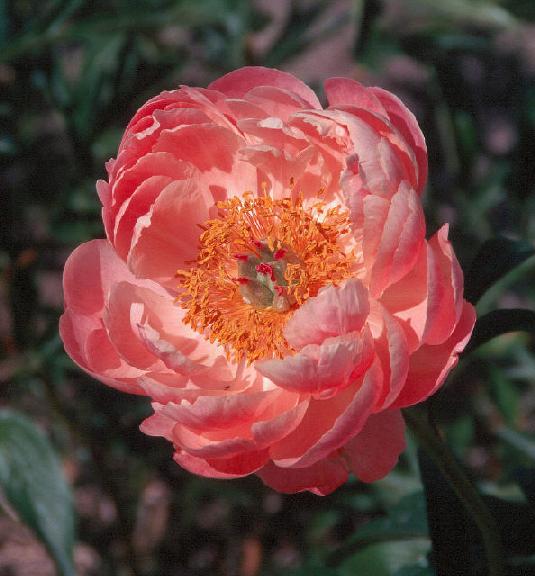These types include Double, Semi-double, Single, and Japanese
Also see peony plant types
|
|
|
Single Peonies include varieties
of the primary form in which one or more rows of large petals, known as
guards, or guard petals, surround a center of stamens with pollen-bearing
anthers which in turn surround the pistil. These primary parts are all distinctly differentiated.
1
Single Peonies have one or more rows of petals made up of five or more
guard petals surrounding a center of pollen bearing stamen. This
describes the wild-type or species flower also. Imperial Red is an
example of a single peony.
|
|
|
|
Japanese Peonies are next in the
process of doubling above the normal single form. They include varieties
in which the pollen bearing stamens have become more or less transformed
into staminodes or narrow petaloids, showing vestiges of the yellow of
the anthers. The partially transformed stamens may cary a trace of
pollen, but are usually not pollen bearing. The name of 'Japanese'
is somewhat misleading inasmuch as the varieties of this class are not
necessarily of Japanese origin; but because the Japanese people have long
admired this type of peony, the name has come to be used to designate the
class.1
The "Anemone Type" resembles somewhat the Japanese but is distinguished from that by the absence of antheres of any kind, while the filaments of the stamens have taken on a petal-like character, being narrow, more or less incurved and imbricated. While this character is constant in some varieties there are others where it appears in side blooms and flowers borne by one- or two-year-old plants.1 Gertrude Allen is an example of a Japanese peony.
|
|
|
|
The "Semi-doubleType" is well marked
and includes som ot the most artistic blooms. Flowers of this type
never becomeFull Doubles and always show a greater or less number of broad
petals intermixed with the stamens, the latter always a prominent feature.1
Semi-Double Peonies are peonies which are have more than one row of petals
emerging from the crown of the flower with the crown of the flower
exposed. The pollen bearing anthers can be seen while the flower
is in bloom. Coral Charm is a semi-double peony.
|
|
|
|
Double peonies are of those peonies
which have multiple rows of petals
emerging from the crown of the flower with the crown of the flower covered by petals. In the "DoubleType" the transformation of the stamens and sometimes the stigmas into petals has advanced to that stage where they make up the main body of the flower, sometimes leaving no trace whatsoever of either stamen or stigma, and in others still showing these to a greater or less extent imbedded among the petals. In some varieties of this type the guard petals are shorter than the petaloids, thereby forming a globular bloom. In others the guard petals are longer and prominent, thereby foming the so-called "Bomb Type." But this form is not constant and often in the same bloom which starts with prominent guard petals, the petaloids keep on developing until they nearly obliterate the guards and eventually make a globular bloom.1 Paul M. Wild(pictured below) is a good example of a double peony.
|
|
|
|
|
In some varieties of the Double
type the guard petals are shorter than the petaloids, thereby forming the
globular bloom. In others the guard petals are longer and prminent,
thereby forming the so-called "Bomb Type." But this form is not constant
and often in the same bloom which starts with prominent guard petals, the
petaloids keep on developing until they nearly obliterate the guards and
eventually make a globular bloom.1
The stamen of the "Bomb Type" are transformed to substantial petals. No pollen is present. These may or may not have the flower-in-flower anatomy, but petals should always develop such as to form a smoothly sculptured, ball-shaped center. Side-buds and reduced flowers of immature plants or plants in poor growing conditions sometimes appear as anemone form. Raspberry Sundae is a good example of a "Bomb Type" peony.
|




